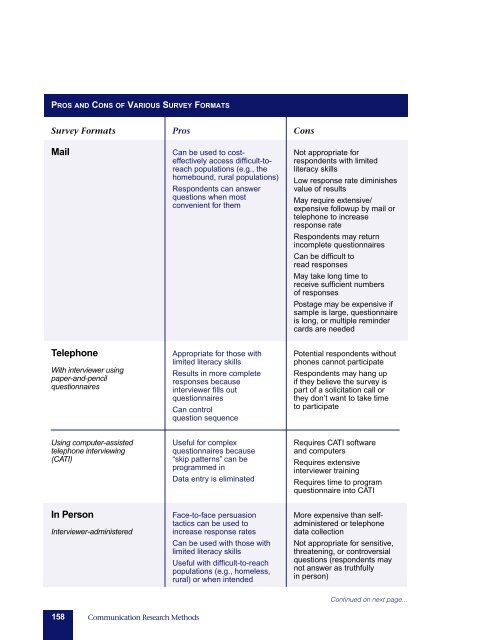pink-book
pink-book
pink-book
You also want an ePaper? Increase the reach of your titles
YUMPU automatically turns print PDFs into web optimized ePapers that Google loves.
PROS AND CONS OF VARIOUS SURVEY FORMATS<br />
Survey Formats<br />
Mail<br />
Pros<br />
Can be used to costeffectively<br />
access difficult-toreach<br />
populations (e.g., the<br />
homebound, rural populations)<br />
Respondents can answer<br />
questions when most<br />
convenient for them<br />
Cons<br />
Not appropriate for<br />
respondents with limited<br />
literacy skills<br />
Low response rate diminishes<br />
value of results<br />
May require extensive/<br />
expensive followup by mail or<br />
telephone to increase<br />
response rate<br />
Respondents may return<br />
incomplete questionnaires<br />
Can be difficult to<br />
read responses<br />
May take long time to<br />
receive sufficient numbers<br />
of responses<br />
Postage may be expensive if<br />
sample is large, questionnaire<br />
is long, or multiple reminder<br />
cards are needed<br />
Telephone<br />
With interviewer using<br />
paper-and-pencil<br />
questionnaires<br />
Appropriate for those with<br />
limited literacy skills<br />
Results in more complete<br />
responses because<br />
interviewer fills out<br />
questionnaires<br />
Can control<br />
question sequence<br />
Potential respondents without<br />
phones cannot participate<br />
Respondents may hang up<br />
if they believe the survey is<br />
part of a solicitation call or<br />
they don’t want to take time<br />
to participate<br />
Using computer-assisted<br />
telephone interviewing<br />
(CATI)<br />
Useful for complex<br />
questionnaires because<br />
“skip patterns” can be<br />
programmed in<br />
Data entry is eliminated<br />
Requires CATI software<br />
and computers<br />
Requires extensive<br />
interviewer training<br />
Requires time to program<br />
questionnaire into CATI<br />
In Person<br />
Interviewer-administered<br />
Face-to-face persuasion<br />
tactics can be used to<br />
increase response rates<br />
Can be used with those with<br />
limited literacy skills<br />
Useful with difficult-to-reach<br />
populations (e.g., homeless,<br />
rural) or when intended<br />
More expensive than selfadministered<br />
or telephone<br />
data collection<br />
Not appropriate for sensitive,<br />
threatening, or controversial<br />
questions (respondents may<br />
not answer as truthfully<br />
in person)<br />
Continued on next page...<br />
158 Communication Research Methods


